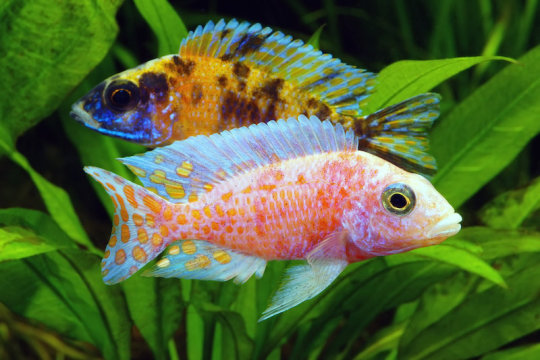[ad_1]
Cichlids (Cichlidae) are a group of small to medium-sized fish that are ubiquitous in freshwater habitats in the tropics. They are particularly notable in exhibiting a wide range of morphological and behavioral specializations, such as various modes of parental care, including mouthbrooding. Some species (mainly members of the genus Tilapia) have achieved fame as culinary delicacies and are of considerable economic significance. Cichlids have undergone rapid diversification in Africa, which is home to at least 1100 species. This process has been especially prominent in the Great Lakes in East Africa’s Rift Valley (Lakes Tanganyika, Malawi and Victoria), where it is referred to as the East African Radiation.
“Cichlid diversification in East Africa has become a central paradigm in evolutionary biology. As a consequence, dating the onset of the process and understanding the mechanisms that drive it are issues of great interest to evolutionary biologists and paleobiologists,” says LMU paleontologist Professor Bettina Reichenbacher, who is also member of the GeoBio-Center at LMU. Fossils from the area provide the sole source of direct evidence that would allow one to determine the timing and trace the course of lineage diversification within the group. However, the search for cichlid fossils has proven to be both arduous and extremely time- consuming. Indeed, only about 20 fossil species of cichlids from Africa have yet been formally described.
In a study that appears in the online journal Scientific Reports, a team of researchers led by Bettina Reichenbacher now describes a new fossil cichlid, which the authors assign to the new genus Oreochromimos. The name derives from the fact that the specimens, which the team discovered in Central Kenya, show similarities to members of the Tribe Oreochromini (hence the element ‘mimos’, meaning ‘mimic’, in the genus name), which are widely distributed in Africa today. “Determining whether or not the fossils could be assigned to any of the extant cichlid lineages was particularly challenging,” says Stefanie Penk, first author of the study and a doctoral student in Reichenbacher’s group. The difficulties are rooted in the great diversity of the modern cichlid fauna in Africa, and the fact that even distantly related species may be morphologically very similar to each other. “The architecture of the skeleton in cichlids is pretty conservative. All of them have a similar basic form, which undergoes very little change during speciation,” Reichenbacher explains. In collaboration with Dr. Ulrich K. Schliewen, co-author of the new paper, Curator of Fishes at the Bavarian State Collection for Zoology in Munich (SNSB-ZSM) and also a member of the GeoBio-Center at LMU, the team adopted the ‘best-fit approach’ to the classification of the fossil specimens. This requires comparison of the fossil material with all the relevant modern lineages of cichlids. In light of their contemporary diversity, that might seem an impossible task. But thanks to Schliewen’s knowledge — and the range of comparative material represented in the collection under his care — the strategy succeeded.
A unique glimpse of the past
Reichenbacher and colleagues recovered the Oreochromimos material from a fossil-fish Lagerstätte in Kenya’s Tugen Hills, which lie within the Eastern Branch of the East African Rift System. This site provides a unique window into the region’s past. The volcanic and sedimentary rocks deposited here date back 5-20 million years. They were overlain by younger material and subsequently uplifted to altitudes of as much as 2000 m by tectonic forces. As a result, the fossil-bearing rocks exposed in the Tugen Hills are either inaccessible to exploration or have been lost to erosion in other parts of Africa. Consequently, the strata here contain a unique assemblage of fossils. Undoubtedly the best known finds so far excavated are the 6-million-year-old remains of a hominin species, which has been named Orrorin tugenensis (orrorin means ‘original man’ in the local language). But cichlid fossils are also among the paleontological treasures preserved in these sedimentary formations — and they are at the heart of Reichenbacher’s Kenya Project, which began in 2011. The material collected so far was recovered in cooperation with Kenya’s Egerton University, and is now on loan to LMU’s Department of Earth and Environmental Sciences for further study.
The Oreochromimos specimens are about 12.5 million years old, which makes this genus the oldest known fossil representative of the Tribe Oreochromini. It therefore qualifies as the oldest fossil clade yet assigned to the Haplotilapiini, the lineage which gave rise not only to most of the species that constitute the present-day diversity of African cichlids, but also to the East African Cichlid Radiation in the Great Lakes of the Rift Valley. With their use of an innovative approach to comparative systematics, the authors of the new study have provided a basis for the taxonomic assignment of future finds of fossil cichlid material. “With the aid of this dataset, it will be possible to classify fossil cichlids much more reliably than before and thus to shed new light on their evolutionary history,” says Bettina Reichenbacher.
Story Source:
Materials provided by Ludwig-Maximilians-Universität München. Note: Content may be edited for style and length.
[ad_2]















